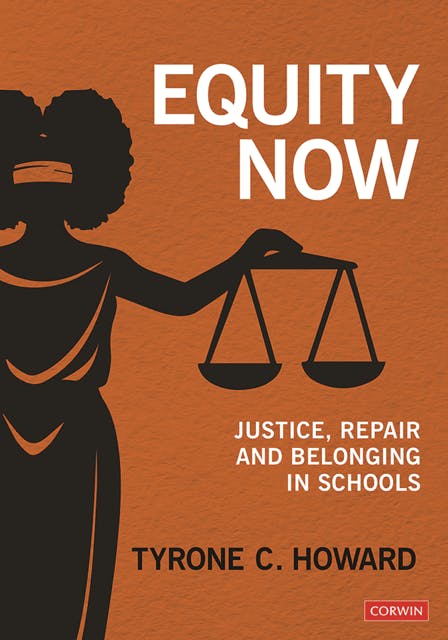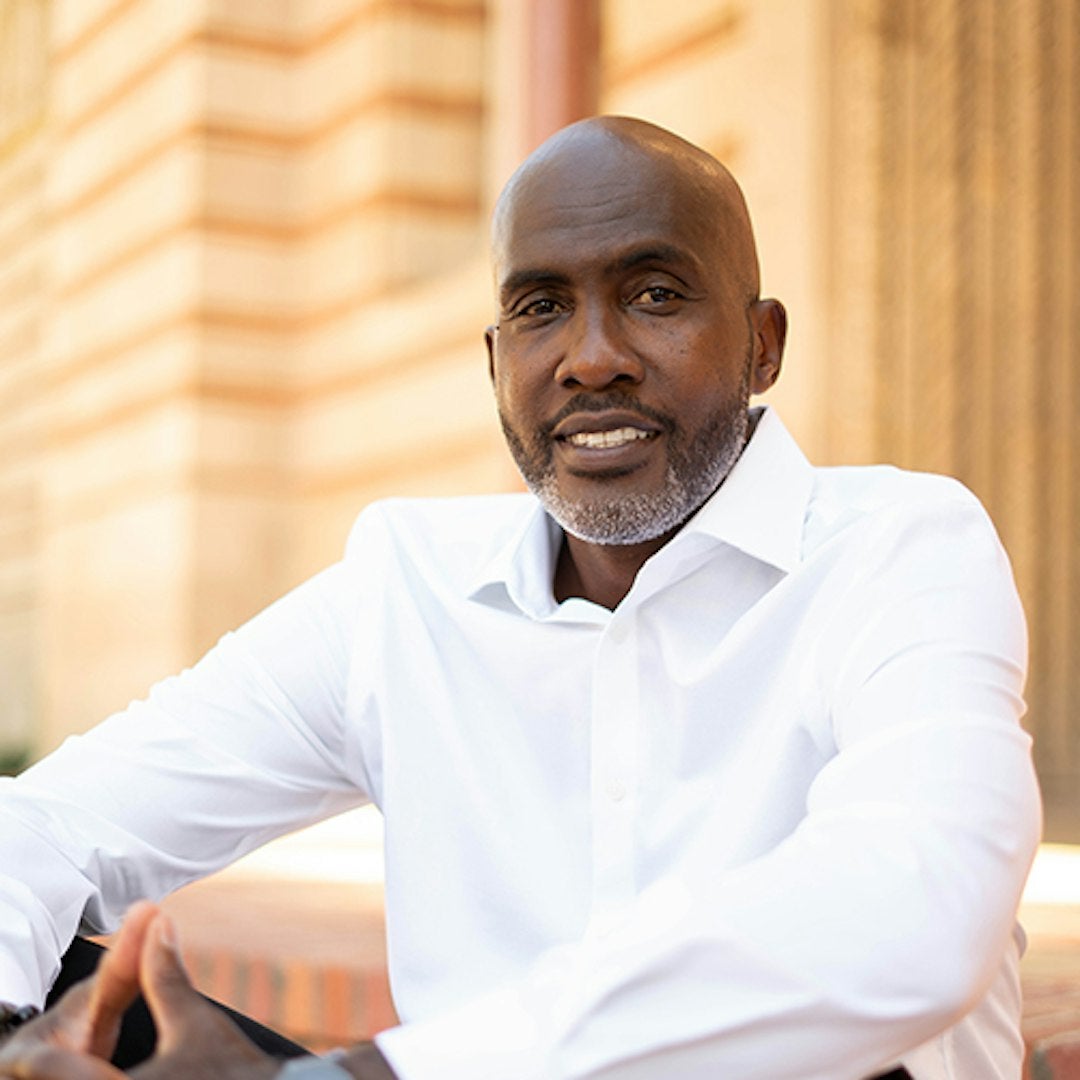New book outlines a path toward equity
In the field of education, the term “equity” at times seems to be omnipresent, just one more piece of education jargon, its use bordering on excessive. The reality however is that while equity is essential to educational opportunity, in many classrooms, schools, and districts, there is little understanding of the meaning and import of equity, its practice is limited, and meaningful and effective commitment to it is in short supply. In his new book, ”Equity Now,” UCLA education professor Tyrone C. Howard, argues that the need for equity in education is urgent.
“We need a hard reset on educational equity and racial justice in schools,” Howard writes. “We need equity now. Not next week, not next month, not next year, but in a much more urgent fashion, as in now.”

“Equity Now” by Tyrone C. Howard published by Corwin
It is a need made only more urgent Howard contends by the decimating impact of COVID-19 on students, especially those of color from low-income backgrounds, and our current political moment, where some intentionally seek to deny the nation’s history and the impact of racism on educational access and opportunity.
In the book, Howard sets out to define what equity is and why it matters, how it can be used, and what can be done to make its comprehensive and effective use central to the efforts of educators and a reality for students in the nation’s classrooms, schools and communities.
“Equality is the goal,” Howard writes, “equity is the mechanism or process we will use to get there.”
The book defines equity as providing the necessary supports, interventions, and actions to correct past wrongs with the goal of justice and belonging for all students, of being just, acknowledging and addressing past harms, and being fair to create equal opportunity.
“When we talk about equity as opposed to equality,” Howard writes, “we must understand that at the outset of formal education in the United States, not everyone was provided the same opportunity, and there has been an incessant game of catch-up ever since.”
Howard offers the example of a 100-yard race. If one participant can start at the 50-yard mark while others are at the starting line, we cannot ignore the significant head-start advantage that one of the runners has over the others. The runners at the starting line can run with the same amount of effort, stride, and form, but it will not matter, they will still lose the race. In such an example, the lack of fairness is evident. This, Howard contends, is in many ways how we need to think about educational equality in the United States.
“The same groups have been behind for centuries in a never-ending game of catch-up,” Howard writes. “How can we provide more supports, resources, time, attention and advocacy for those groups that have been historically disadvantaged to create more equal schooling opportunities?”
In “Equity Now,” Howard makes the case that children need and deserve more equitable practices and more equitable schools, and, importantly, seeks to show what that looks like in practice. Aiming to set educators on a pathway to achieve equality through a renewed focus on equity, the book lays out Howard’s foundational principles of an equity framework anchored in a commitment to justice, the recognition and repair of past harms, and the concept of belonging – that people want and need to be included, seen, heard and valued.
“In so many ways, this book is rooted in those ideas of justice that my parents instilled in my brother and me—to try to always do what is right and to always be mindful of those in greatest need,” Howard writes. “That is the conception of justice that anchors this book that is desperately needed in schools today. Do right by all students, but pay particular attention to those in greatest need.”
“Equity Now” addresses the historical context of educational opportunity, details the dramatic and uneven impact of the COVID-19 pandemic on students and the urgent need to respond to their needs, and addresses the current political moment marked by polarizing partisan efforts that seek to deny the full exploration of history, curtail diversity, equity and inclusion practices, and limit discussion or race and racism.
“Equity Now” is intended to serve as a comprehensive source and guide for educators. Individual chapters address district-level equity efforts, school-wide equity and school leadership, equity in the classroom, the engagement of parents and caregivers in efforts to further equity, and the need for and use of data through an equity lens. Along the way, Howard offers strategies, examples, and practices to further equity, as well as questions and resources to fuel deeper learning.
Calling on educators to move from “safe spaces” to” brave places” to address disparities, Howard contends the urgent need for achieving educational equity in our current educational moment calls for an “all hands on deck” effort, and that creating equitable schools is everyone’s responsibility or duty.
“We need bold leadership, courageous adults, and caring individuals to stand up to the current political moment to say that students should always be first,” Howard writes.
“Equity Now: Justice, Repair, and Belonging in Schools,” is published by Corwin Press. We talk briefly with Professor Howard about “Equity Now” here:
In your new book you try to define what equity is and why it matters. So, let’s start at the beginning. What is equity?
Equity is a concept that recognizes that we need to provide certain advantages, opportunities, supports, and interventions to people who have not had them historically. Not everyone begins their educational journey from the same spot. Equity recognizes that people have not always had the same privileges, others have had much greater advantages, and says, let’s give an additional boost, additional resources, time and support to students who begin from behind to help them catch up so that all succeed. Equality needs to be our goal. Equity is our pathway to get there.
I have also tried to address the gap between how we understand the concept of equity, and what equity looks like in practice. Equity in action rests on the idea that large segments of today’s student population are not receiving the type of education that they deserve. The overwhelming number of students who come from racially diverse and low-income backgrounds are among those most in need of better educational opportunities. Students who are among our most vulnerable need something different in today’s schools. We have to be bold enough to be prepared to give more to specific groups that have historically gotten less.
In “Equity Now, you say the need for equity is urgent. Why?
In the book, I write about how from the beginning of the United States, there has always been a distinction between who has access to schooling and who does not. Girls and women, poor whites, Indigenous people, and enslaved Africans were not deemed worthy of access to education. From the outset, inequities were essentially baked into our nation’s educational DNA. This May, as we recognize the 70th anniversary of Brown v. Board of Education, which aspired to offer the promise of educational equality, stubborn educational inequities that fall along racial and economic lines remain. It should come as no surprise that Black, Indigenous, Latinx, and Asian Pacific Islander students are consistently behind their white counterparts in meaningful measurements of learning and academic achievement. The United States is undergoing huge demographic changes and these students will soon make up a majority of students in our schools. What happens if 60 or 65 percent of students in the nation don’t do well? We urgently need to address their learning needs.
Even before the COVID-19 pandemic, there were serious gaps in learning and achievement between low-income students of color and their white counterparts. The pandemic hit schools like a tsunami, with a loss of educational opportunity for millions, and a disproportionate impact on low-income families and communities of color. In the wake of the pandemic, the disparities between students have only grown wider, with serious impacts on learning and potentially long-lasting ramifications. As I write in the book. We urgently need an equity-based approach to the growing gaps that are occurring with millions of students across the country.
It is also important to make clear that our current political moment makes the need for equity now even more urgent. In the book, I write about the polarizing partisan politics in our society that have permeated schools. We are confronted with organized attacks on diversity, equity, and inclusion, efforts to limit teaching about race and racism, heated conflicts over gender, gender identity and sexual orientation, and the banning of books. It is frightening and outright harmful for students.
I think the current political moment is driven by resentment about increasing diversity, and is centered around anti-equity and anti-diversity and anti-inclusion beliefs because there is a false narrative that suggests people are getting things that they’ve not worked for, or this idea that somehow folks who have had power historically, are being denied opportunities that they really should have. This moment is critical because the very things that we are fighting for are under attack and are being rolled back. This is a time we should be talking about our diversity and celebrating and embracing our diversity as something we as a nation should be proud of. But now, educators are afraid and teachers feel they are being silenced. I think it leads us down a road where we’re just trying to keep a happy status quo and we are not going to talk about people’s realities, their histories, and their obstacles. If we can’t talk about our different experiences, our different backgrounds, and different challenges and triumphs, how do we come to understand what supposedly makes America so great? So, for me, I get worried about this current moment, because there is such hostility, and such angst and venom towards equity, that we have to double down and push for it even harder now than we did before.
So where do we go from here? How do we get to “Equity Now”?
I hope the book can help. I’ve tried to frame the work around three foundational tenets – justice, the recognition and repair of past harms, and a focus on belonging to guide the effort. Equity is rooted in justice, which I define as doing the right thing for students. We truly need to put students first and focus on those who are most disadvantaged.
The book is primarily aimed at educators and offers specific chapters for school districts, school leaders, teachers, and also parents and caregivers. It offers each group specific suggestions, strategies, examples and practices for furthering equity. And there are ideas for using data in ways that further equity. There are also questions and resources that I hope will prod further learning and foster conversations that move into action, that help us to begin to think differently in terms of what we do around equity, and not just talk about it, but to see it manifested in our policies and practices.
Importantly, I am also asking all of us to move from safe spaces to brave places in an all-out, all-hands-on-deck effort to place equity at the center of our educational systems, schools, and classrooms. This is not about superficial approaches to equity, but deep-seated ways in which we build a culture that is grounded in equity. As I say in the book, it is not for the faint of heart.
